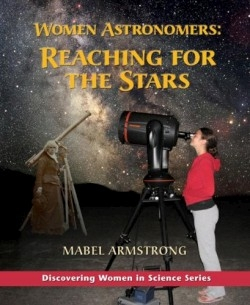Women Astronomers
Reaching for the Stars
- 2008 INDIES Winner
- Gold, Young Adult Nonfiction (Children's)
While recent surveys by the American Astronomical Society report more women are entering the field, most people would agree that astronomy is a male-dominated endeavor. The author of this text would have you know, however, that “women have always studied the night sky.”
Part of a series, Discovering Women in Science, this book tells the stories of twenty-one female astronomers and their struggles for success and acceptance. In writing the book, the author may be attempting to right a personal injustice. After studying chemistry, Armstrong claims she was unable to get a job in the industry—not for lack of training, but because she was a woman. By exposing her intended readers, middle school and high school girls, to the historical and personal histories of female scientists, the author hopes to inspire them to consider a scientific vocation themselves.
As Armstrong reaches back into ancient times, her exploration of the female astronomer yields many surprises. The Babylonian Chief Astronomer Priestess of the Moon Goddess of the City, also known as EnHeduanna (circa 2350 B.C.E.), managed a large network of astronomer priestesses. They helped establish the calendars still in use today. And Galileo may have been the first to develop the telescope in 1610, but Armstrong declares that it was Caroline Lucretia Herschel (b. 1750) working with her brother William, who revolutionized the tool. The Herschel’s “catalog of 2,600 nebulae ignited a world-wide debate about their identity.” In the early 1900s, Harvard Observatory trained some of the first American women astronomers, including Williamina Stevens Fleming (b. 1857). She developed a system of classifying stars by the wavelength of the light they emit.
The third person narrative and engaging language keep the reader’s attention. A handy timeline tracing the history of astronomy from 4000 B.C.E. to modern times runs along the bottom of many pages. Illustrations and photographs decorate each page, but color would have greatly enhanced their presentation. This book will become a good reference for educators and guidance counselors of students in this demographic, as well as anyone interested in an easy-to-read history of women in astronomy.
Reviewed by
Mary Spiro
Disclosure: This article is not an endorsement, but a review. The publisher of this book provided free copies of the book to have their book reviewed by a professional reviewer. No fee was paid by the publisher for this review. Foreword Reviews only recommends books that we love. Foreword Magazine, Inc. is disclosing this in accordance with the Federal Trade Commission’s 16 CFR, Part 255.

